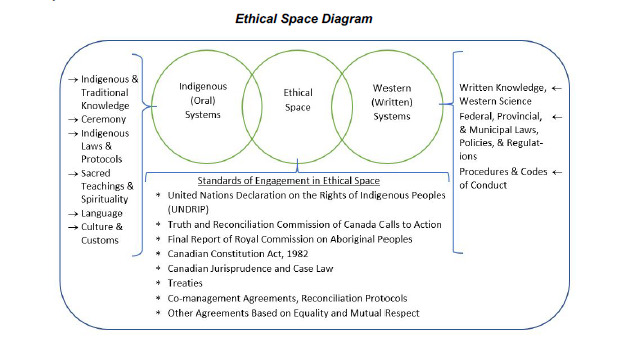The ESE (process): Difference between revisions
No edit summary |
|||
| Line 3: | Line 3: | ||
In this particular case, you are presented with the guiding principles of the ‘Ethical Space of Engagement’ (ESE), as proposed by Sturgeon Lake First Nation elder Willie Ermine (Ermine 2007). The ESE, is a “third space” approach, through which differentiated nations or collectives might negotiate ethical encounters with each other in an ‘ethical’ space that belongs to neither. This third space emerges both through principled practices (like for example negotiating terms of engagement), and as a condition for- in the case of my research- (non-)Indigenous- and Euro-Canadian knowledge systems to re-position themselves as more equitable partners-in-encounter (Ermine, 2007; Ermine 2015; Indigenous Circle of Experts 2018). | In this particular case, you are presented with the guiding principles of the ‘Ethical Space of Engagement’ (ESE), as proposed by Sturgeon Lake First Nation elder Willie Ermine (Ermine 2007). The ESE, is a “third space” approach, through which differentiated nations or collectives might negotiate ethical encounters with each other in an ‘ethical’ space that belongs to neither. This third space emerges both through principled practices (like for example negotiating terms of engagement), and as a condition for- in the case of my research- (non-)Indigenous- and Euro-Canadian knowledge systems to re-position themselves as more equitable partners-in-encounter (Ermine, 2007; Ermine 2015; Indigenous Circle of Experts 2018). | ||
[[File:Ethical Space of Engagement (IISSAAK OLAM FOUNDATION, 2019).png|border]] | |||
Figure 1: The Ethical Space Diagram, as published by the IISAAK OLAM foundation (2019) | |||
Revision as of 22:54, 24 November 2024
You have found a vista. A vista is a site from which a particular view or prospect is offered. Vistas can quite literally offer a horizon to assist in your navigation, like the outline of rock formations and shorelines would do within Inuit Nunangat. In the case of my knowledge-land-scape, they offer “visions”, mental images that may serve as guidelines to set out and adjust your course during the journey to come.
In this particular case, you are presented with the guiding principles of the ‘Ethical Space of Engagement’ (ESE), as proposed by Sturgeon Lake First Nation elder Willie Ermine (Ermine 2007). The ESE, is a “third space” approach, through which differentiated nations or collectives might negotiate ethical encounters with each other in an ‘ethical’ space that belongs to neither. This third space emerges both through principled practices (like for example negotiating terms of engagement), and as a condition for- in the case of my research- (non-)Indigenous- and Euro-Canadian knowledge systems to re-position themselves as more equitable partners-in-encounter (Ermine, 2007; Ermine 2015; Indigenous Circle of Experts 2018).
Figure 1: The Ethical Space Diagram, as published by the IISAAK OLAM foundation (2019)
When taking the ESE as a guiding frame, ethics are no longer a pre-emptive box to tick nor a static end-goal. Ethical research is rather performed as a dynamic state of becoming which requires ongoing negotiation and decolonization.
When looking out over this Vista, you wonder what it means in the thick moment/um of reconciliation to think of knowledge co-production in accordance with the guiding principles of the Ethical Space of Engagement. In particular you wonder about the processes of collaboration that happen ‘within’ such an “ethical” space of engagement. How do people navigate their sense of self and other within a space that exists outside of their own cultures?
Perhaps you can spot some boundaries when you hop over onto some of the other rocks in front of you?
Boundaries
From this rock you can clearly see, that the knowledge-land-scape, that you are about to enter is comprised of (digitized) materials. They are ethnographic traces like voice notes, photos, drawings, edited videos, written notes, posters and presentations, as well as academic texts and workshops, resulting from the more-than-human aesthetic encounters that were part of my fieldwork. My knowledge-land-scape is explicitly not about providing “direct” access to the land or Inuit Qaujimajatuqangit (nor is such a thing possible, or desireable). It adheres to Inuit-driven EEE protocol 3 , in that it respects cultural “differences”. My work does not somehow make otherwise “remote” regions legible, accessible or available for consumption. Nor does it take the liberty to “represent” IQ, or “map out” Inuit Nunangat as if it were a blank slate, or “empty” space available for inscription or re-interpretation by non-Inuit researchers like me. As such it not meant to be taken as a descriptive representation, but instead as an emergent event – an emergent topology of my own research that materializes in-between subject-object, reader-author, and land-scape encounters. As such not everything is possible within this knowledge-land-scape. The land-scape as it emerges within this web-based platform is not meant to sketch a comprehensive and complete overview of the institutional or socio-political apparatus of community-based polar bear management. It is rather bounded by the particular more-than-human encounters of my fieldwork, the apparatus of western science and polar bear co-management, available resources and the technical affordances of the software with which it was built- as well as the intra-dynamics of all these matters and my decisive cuts as a researcher.
As you closely study the land-scape again, you clearly see some of these decisive cuts. They take the shape of different tracks that run through and between all kinds of different landmarks. Although you can’t see where they lead, you can tell that the track you are currently on takes you along the unfolding of the Bearwatch project. Return to your original path and continue moving across this knowledge-land-scape landscape, while paying extra attention to the things around you.

